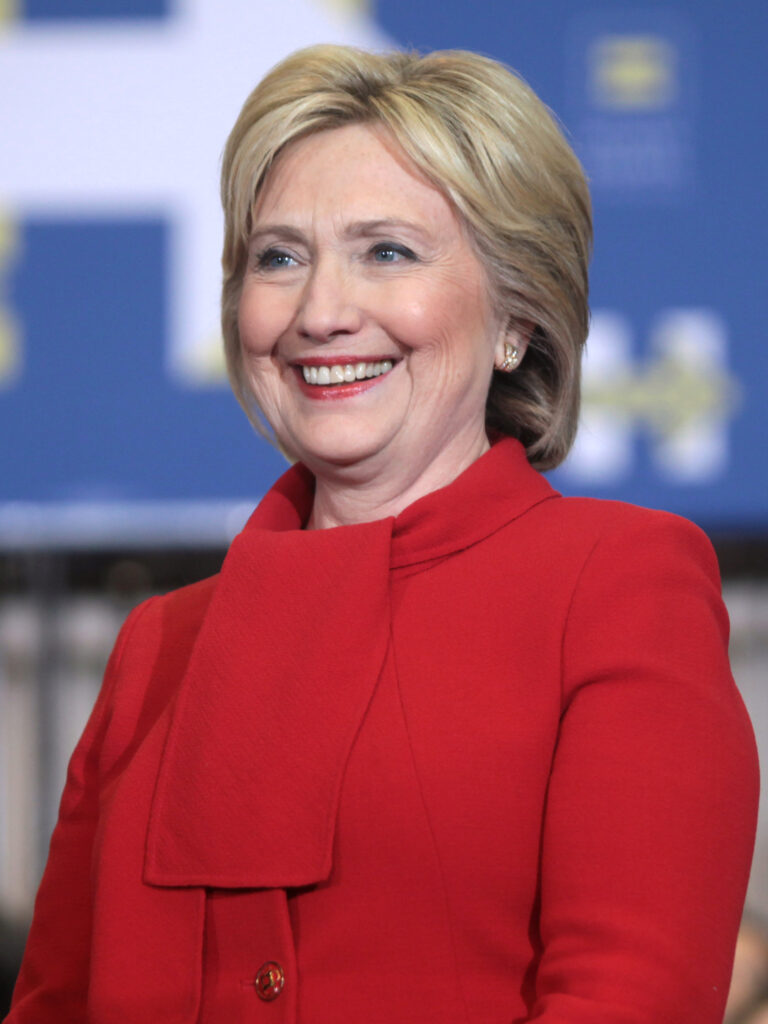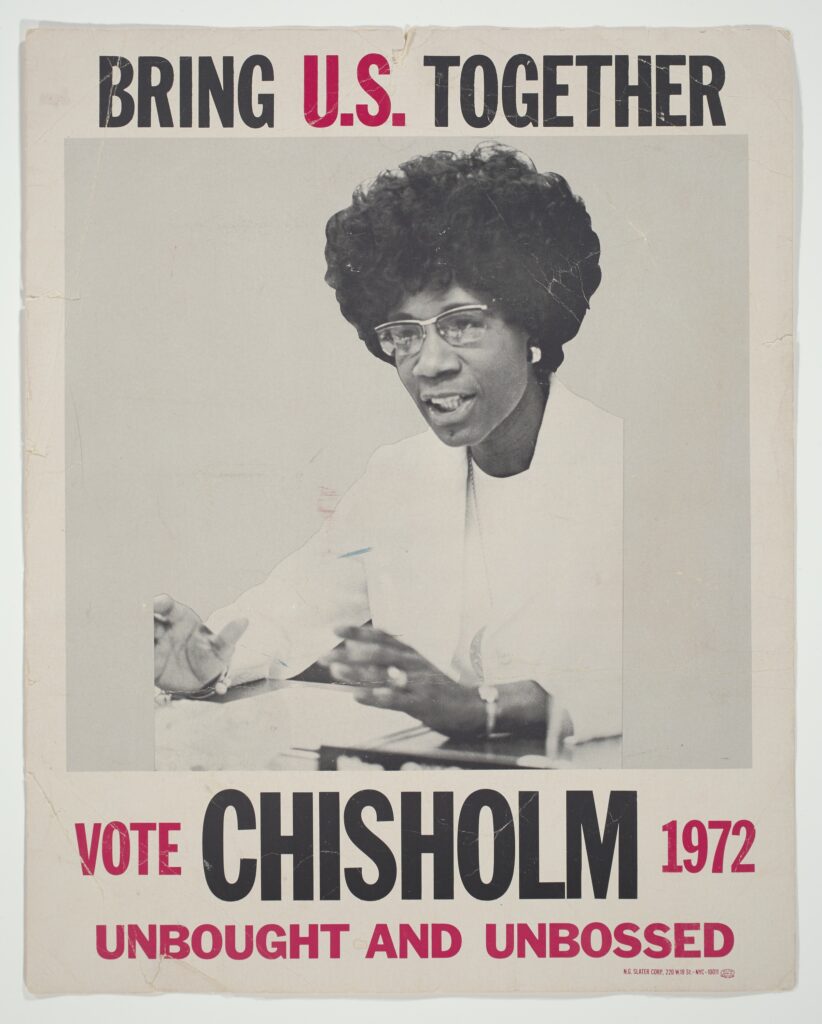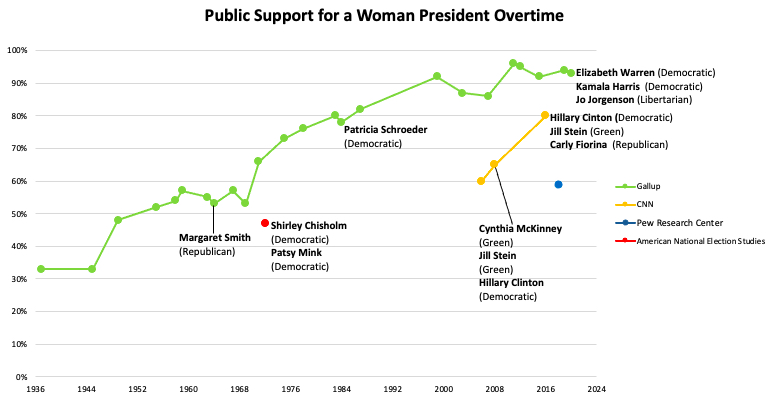Women for Executive Office: How Public Opinion on Women Running for Executive Office has Changed Over Time
Elena Bresnan ’22 (ebresnan@muhlenberg.edu) & Liv Barry ’22 (lbarry@muhlenberg.edu)

(Gage Skidmore) 
(National Museum of African American History & Culture) 
(Office of Senator Kamala Harris)
Public Opinion on Women Candidates
This research aims to study the following question: how has public opinion on women who have run for the presidency changed over time? We are using the research method of aggregate data analysis to compare public opinion on women presidential candidates throughout the years. In doing so, we are comparing the results of differing public opinion surveys, over time, focusing on public support for female presidential candidates. We found a positive trend towards becoming accepting of women in executive offices, but recognize that factors such as social desirability may affect the positive outcomes of these surveys, and over exaggerate public support of women for president. By comparing different sources of public opinion data on support for female presidential candidates, we can gauge the current state of public opinion on the matter and whether or not the public would truly be in support of a woman president. Additionally, we compared the data on support for female candidates with years that women sought party nomination.
Findings from the Literature
Political Climate
When considering the results of public opinion polls regarding women running for executive offices, one has to consider the current political climate that may influence how individuals may respond to the questions being asked. Depending upon the political climate surrounding gender at the time, people may feel pressured to answer questions a certain way despite their answers not reflecting their true political views. Matthew J. Streb et. al. found this to be particularly relevant when considering public opinion surveys interested in public opinion on support for a female American President; the researchers argue that due to the controversial nature of such questions, the responses may suffer from social desirability effects (Streb et al 2008). After gathering their results, researchers found that roughly 26% of the public would be angry or upset at the prospect of a female president. Given the results of this research, factors of social desirability must be considered when evaluating public support for female candidates running for executive office positions. Studies have shown, however, that public support for women in politics has risen significantly over time; currently only “13 percent of both men and women now think that women are less suited for politics than men” which signifies a change of “about 37 percentage points since 1975, when the average peaked at nearly 50 percent” (Carnevale et al 2019). While this progress is significant, the remaining 13 percent is evidence that sexism persists.
Presence of Sexism
Public perception of female candidates running for executive office plays a significant role, as gender and sexism reveal themselves to be prominent contributors of opinion on the candidate. Before 2016, neither the Democratic or Republican party had nominated a female presidential candidate (Smith et al., 2007) highlighting the absence of women in the presidential realm through the lens of major parties and their nominations. Smith et al., in their study, researched the role that gender-bias has played in presidential candidates, specifically pointing to the way in which gender bias reveals itself in different areas of the government.
In surveying two groups of undergraduate students, which included both male and female students, Smith et al. found differences in the survey results based on what the female candidate was running for. The first group looked at two names, Brian Miller and Karen Miller, (Smith et al., 2007) who were both candidates for the Senate. The researchers, in their evaluations, found that there was no evidence of gender playing a role in choosing a candidate. For the second group, though, which surveyed students on presidential candidates, the group of candidates included both a male and female name, as well as an added gender-neutral name. The results found that the female candidate was ranked the lowest in terms of choosing, the gender-neutral candidate was ranked in the middle, and the male candidate’s name was ranked the highest (Smith et al., 2007). This reflects the presence of gender-bias, including the perception of the presidency as a male candidate’s prerogative, but a greater acceptance towards female candidates in other political positions of power.
American Women Presidential Candidates Throughout History
| Victoria Woodhull | 1872 | Equal Rights Party |
| Belva Lockwood | 1884 1888 | Equal Rights Party |
| Margaret Smith | 1964 | Republican Party |
| Shirley Chisholm | 1972 | Democratic Party |
| Patsy Mink | 1972 | Democratic Party |
| Ellen McCormack | 1976 1980 | Democratic Party Right to Life Party |
| Sonia Johsnon | 1984 | Citizens Party |
| Patricia Schroeder | 1984 | Democratic Party* |
| Lenora Fulani | 1988 1992 | New Alliance Party |
| Elizabeth Dole | 2000 | Republican Party |
| Carol Braun | 2004 | Democratic Party |
| Cynthia McKinney | 2008 | Green Party |
| Michele Bachmann | 2012 | Republican Party* |
| Jill Stein | 2008 2016 | Green Party |
| Hillary Clinton | 2008 2016 | Democratic Party |
| Carly Fiorina | 2016 | Republican Party* |
| Tulsi Gabbard | 2020 | Democratic Party |
| Kirsten Gillibrand | 2020 | Democratic Party* |
| Kamala Harris | 2020 | Democratic Party* |
| Elizabeth Warren | 2020 | Democratic Party |
| Mariane Williamson | 2020 | Democratic Party* |
| Amy Klobuchar | 2020 | Democratic Party |
| Jo Jorgenson | 2020 | Libertarian Party |
Source: “Women Presidential and Vice Presidential Candidates: A Selected List.” CAWP, September 28, 2020. https://cawp.rutgers.edu/levels_of_office/women-presidential-and-vice-presidential-candidates-selected-list.
- The table above provides the historical background of the most prominent women presidential candidates. We used this figure to help garner an understanding of the women candidates, as it allows for a clear look at the women who have run for the presidency over time.
What We Found:

Sources: Inc, Gallup. “The Presidency.” Gallup.com, July 18, 2007. Media Inquiries. “Americans’ Views of Women as Political Leaders Differ by Gender.” Pew Research Center (blog). Accessed November 3, 2020. Vavreck, Lynn. “Changing Views on a Female President (Published 2015).” The New York Times, ANES, June 19, 2015, sec. The Upshot. CNN. “Poll Results: Is the U.S. Ready for a Female President? – CNNPolitics.” Accessed December 3, 2020.
- This figure provides a general overview of how public opinion on women running for president has changed over time. The Gallup poll asked the following question: “If your party nominated a generally well qualified person for president who happened to be a woman, would you vote for that person?” In addition to that poll, we also included data from CNN, the Pew Research Center, and the American National Election studies. The question asked by CNN, which we have sampled data from, is the following: “Do you think America is ready for a woman president or not?” Survey respondents from the Pew Research Center answered a question asking if there are too few women in high political offices in the country today. The American National Election Studies asked: “Some people feel that women should have an equal role with men in running business, industry and government. Others feel that a woman’s place is in the home. Where would you place yourself…or haven’t you thought much about this?”
- Although these questions vary in syntax, they all share the same connotation of appraising public support for women in high political offices and roles of power. In order to analyze the differing results of these questions by year, we have compared the public opinion data on women running for president with the years that women actually ran for party nomination or for president in general. By viewing these results, we are able to determine whether or not the candidacy of certain women affected public opinion on women running for the presidency.

Sources: CNN. “Poll Results: Is the U.S. Ready for a Female President? – CNNPolitics.” Accessed December 3, 2020. Inc, Gallup. “The Presidency.” Gallup.com, July 18, 2007. Jones, Jeffrey M. “Hillary Clinton Now More Popular Than Barack Obama.” Gallup.com. Gallup, March 14, 2018. Media Inquiries. “Americans’ Views of Women as Political Leaders Differ by Gender.” Pew Research Center (blog).
- This figure utilizes data on public opinion regarding women running for the presidency from CNN, Gallup polls, and the Pew Research Center. In addition, the data from 2009 comes from a Gallup poll on Hillary Clinton’s favorability. To offer analysis on said data, we have selected the years up to and following Hillary Clinton’s candidacy for the presidency. Although Clinton was not successful in gaining the party nomination in 2008, her candidacy greatly impacted public opinion on women running for the executive office. In 2007, 86% of survey respondents said they would vote for a well-qualified woman if she were nominated by their party; whereas in 2008, Clinton’s first time running for president, only 65% of respondents felt that America was ready for a woman president. The data reflects that Americans viewed the lack of support for Clinton as a general lack of support for women candidates. Additionally, this trend was shown again in 2015, as 92% of respondents said they would vote for a woman candidate. In 2016, only 80% of Americans felt America was ready to elect a woman as president. This illustrates the fact that Clinton’s candidacy affected American’s belief that a woman was capable of being elected president. Whether or not this reflects Clinton’s own popularity — or lack thereof — amongst the public, the general sentiment regarding a woman president stands to be discovered.
What Comes Next?
After collecting and comparing data from multiple sources, it is apparent that public support for women presidential candidates has been on a positive trajectory since 1937. It must be noted, however, that the candidacy of women for the party nomination for the presidency affects the public’s opinion on the likelihood and support for a woman president. For example, our first figure reflects that the data for the year 1972 changed with the candidacy of Shirley Chisholm for president; in 1969, 53% of Americans said that they would vote for a woman for president, whereas only 47% shared that sentiment in 1972. Another woman who has run for the presidency that has shaped public opinion data is Hillary Clinton. Upon her first time running for the party nomination, only 65% of Americans felt that the U.S. was ready to elect a woman as president, despite 86% of Americans expressing that they would elect a woman to the office of the presidency a year prior. Similarly, in 2015 95% of survey respondents would vote for a woman president compared to a mere 80% in 2016, the year that Hillary Clinton was the nominee for the Democratic Party. Despite a gradual shift towards support for a woman president, our data has shown that the candidacy of women for president often results in a slight decline in public support; this may have to do with discouragement from voter turnout, or just a general lack of support for the women running. Although there has been great progress over the years concerning efforts towards gender equality, there are still barriers women face in the professional and political realm; while it may be clear that women are just as qualified for the position of president as men, many more traditional Americans do not see a woman as fitting in the traditional presidential image.
In the face of this critique, public opinion data suggests that a majority of the public is in support of the possibility of a woman president. In our opinion, the issue of a woman becoming president is no longer a question of if, but rather when. Additionally, the role of women in executive offices is highly influential towards public opinion on the matter. It will be of importance to see how public opinion on Kamala Harris as Vice President will impact support for women running for the presidency and other executive offices in the future. It is likely that Harris’ performance as VP will be integral towards the growing support for a woman president. As support has been mounting steadily over time, it may be sooner rather than later that the United States elects a woman to the office of president.
Bibliography
Andrews, Evan. “Who Was the First Woman to Run for President?” HISTORY. Accessed November 3, 2020. https://www.history.com/news/who-was-the-first-woman-to-run-for-president
Bowman et al., “AEI Public Opinion Studies: Public Opinion on Hillary Clinton, 1992-2015,” American Enterprise Institute for Public Policy Research, 2015.
Carnevale et al., “May the Best Woman Win?: Education and Bias against Women in American Politics” Georgetown University. 2019.
CNN. “Poll Results: Is the U.S. Ready for a Female President? – CNNPolitics.” Accessed December 3, 2020.
Goethals, George R., and Crystal L. Hoyt. Women and Leadership: History, Theories, and Case Studies. Berkshire Publishing Group, 2016.
Harris, Office of Senator Kamala. English: Official Headshot of United States Senator Kamala Harris (D-CA). May 12, 2017. https://www.harris.senate.gov/news#photos. https://commons.wikimedia.org/wiki/File:Kamala_Harris_official_photo_(cropped2).jpg.
Inc, Gallup. “The Presidency.” Gallup.com, July 18, 2007. https://news.gallup.com/poll/4729/presidency.aspx
Jones, Jeffrey M. “Hillary Clinton Now More Popular Than Barack Obama.” Gallup.com. Gallup, March 14, 2018. https://news.gallup.com/poll/123665/hillary-clinton-more-popular-barack-obama.aspx.
Media Inquiries. “Americans’ Views of Women as Political Leaders Differ by Gender.” Pew Research Center (blog). Accessed November 3, 2020.
Smith, Jessi L., David Paul, and Rachel Paul. “No Place for a Woman: Evidence for Gender Bias in Evaluations of Presidential Candidates.” Basic and Applied Social Psychology 29, no. 3 (August 14, 2007): 225–33.
Andrews, Evan. “Who Was the First Woman to Run for President?” HISTORY. Accessed November 3, 2020. https://www.history.com/news/who-was-the-first-woman-to-run-for-president
Bowman et al., “AEI Public Opinion Studies: Public Opinion on Hillary Clinton, 1992-2015,” American Enterprise Institute for Public Policy Research, 2015.
“Campaign 2016 Clinton.JPEG-27730.Jpg – Washington Times.” Accessed December 3, 2020. https://m.washingtontimes.com/multimedia/image/campaign-2016-clintonjpeg-27730jpg/.
Carnevale et al., “May the Best Woman Win?: Education and Bias against Women in American Politics” Georgetown University. 2019.
CNN. “Poll Results: Is the U.S. Ready for a Female President? – CNNPolitics.” Accessed December 3, 2020.
Goethals, George R., and Crystal L. Hoyt. Women and Leadership: History, Theories, and Case Studies. Berkshire Publishing Group, 2016.
Inc, Gallup. “The Presidency.” Gallup.com, July 18, 2007. https://news.gallup.com/poll/4729/presidency.aspx
Jones, Jeffrey M. “Hillary Clinton Now More Popular Than Barack Obama.” Gallup.com. Gallup, March 14, 2018. https://news.gallup.com/poll/123665/hillary-clinton-more-popular-barack-obama.aspx.
Media Inquiries. “Americans’ Views of Women as Political Leaders Differ by Gender.” Pew Research Center (blog). Accessed November 3, 2020.
“Poster for Presidential Candidate Shirley Chisholm.” National Museum of African American History and Culture, n.d. Accessed December 5, 2020. https://nmaahc.si.edu/object/nmaahc_2014.167.3.
Skidmore, Gage. English: Hillary Clinton Speaking at an Event in Des Moines, Iowa. January 24, 2016. Own work. https://commons.wikimedia.org/wiki/File:Hillary_Clinton_by_Gage_Skidmore_4_(cropped).jpg.
Smith, Jessi L., David Paul, and Rachel Paul. “No Place for a Woman: Evidence for Gender Bias in Evaluations of Presidential Candidates.” Basic and Applied Social Psychology 29, no. 3 (August 14, 2007): 225–33.
Streb, Matthew J., Barbara Burrell, Brian Frederick, and Michael A. Genovese. “Social Desirability Effects and Support for a Female American President.” Public Opinion Quarterly 72, no. 1 (January 1, 2008): 76–89.Vavreck, Lynn. “Changing Views on a Female President (Published 2015).” The New York Times, ANES, June 19, 2015, sec. The Upshot.